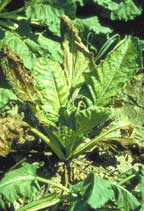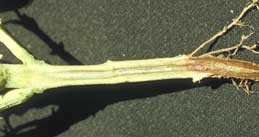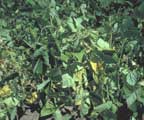by H.F. Schwartz, L.W. Panella, M.A. Brick, and P.F. Byrne* (3/13)
Quick Facts…
- Sugar beets are an important cash crop in northeastern Colorado with approximately 30,000 acres planted and 944,000 tons harvested in 2012.
- Fusarium yellows, also known as Fusarium wilt, is a fungal disease (caused by Fusarium oxysporum Schlechtend.:Fr.) with presumed host-specific strains that attack sugar beet (F. o. f. sp. betae) or dry bean (F. o. f. sp. phaseoli).
- Fusarium wilt losses in dry bean fields can vary from a trace to more than 30 percent crop loss; in addition seed size can be reduced 10 percent to 15 percent.
The Central High Plains (Colorado, Nebraska and Wyoming) is among the largest producer of dry edible beans and sugar beets in the United States. Sugar beet is an important cash crop in northeastern Colorado with approximately 30,000 acres planted and 944,000 tons harvested in 2012. Approximately 250,000 acres of dry bean market types (pinto, great northern, light red kidney) also are planted annually with a farm gate value that varies between $75 and $150 million. With both sugar and dry bean processing plants in Greeley and Fort Morgan, production is centered in northeast Colorado counties. Many growers in this area grow both sugar beets and dry beans in rotation, which may accentuate problems with soil-borne pathogens that attack both crops.
Fusarium yellows, also known as Fusarium wilt, is a fungal disease (caused by Fusarium oxysporum Schlechtend.:Fr.) with presumed host-specific strains that attack sugar beet (F. o. f. sp. betae) or dry bean (F. o. f. sp. phaseoli). Severely infected plants become yellowed, wilted and die prematurely, which may cause yield reduction or total crop loss. Because sugar beets and dry edible beans are commonly grown in a short rotation of less than four years in the Central High Plains, incidence and variability of the pathogens may have increased in recent years. Problems also may be aggravated by regional drought impacts. Fusarium wilt losses in dry bean fields can vary from a trace to more than 30 percent crop loss; in addition seed size can be reduced 10 percent to 15 percent. Reports from eastern Colorado and Wyoming indicate that the disease has been found in many sugar beet fields with significant reduction in yield in various counties.
Problem and Cooperative Project
Because there is no effective chemical protection against this disease at the mature plant stage, it is managed in sugar beet by using resistant sugar beet hybrids and carefully controlling irrigation. Colorado State University personnel have been incorporating disease resistance to local strains of the bean pathogen into pinto bean varieties in recent years. Nonetheless, Fusarium yellows disease continues to be a serious problem for growers throughout the Central Great Plains, such as the Fort Morgan to Sedgwick area of Colorado. Additionally, it is difficult to identify the different species of Fusarium using a microscope and other laboratory procedures, and impossible to determine whether they are sugar beet ordry bean types without a greenhouse test on the plants. Screening for Fusarium yellows requires precise and laborious laboratory andgreenhouse conditions to identify isolates and races of Fusarium oxysporum. Evaluations are not always repeatable or accurate, even with replication; however, recently, methods based on new biotechnologies have been used to “fingerprint” isolates.
During recent years, a multi-disciplinary and multi-agency team of scientists and industry collaborators joined to: 1) define the extent of the disease in sugar beet and dry bean production areas, 2) collect samples of diseased plants, 3) isolate and purify cultures of the pathogen, 4) conduct laboratory tests to study cultural and molecular variability, 5) initiate greenhouse studies to verify pathogenicity of fungal cultures on diverse hosts and germplasm, and 6) develop tools based on new biotechnologies to identify different isolates of the fungus. The ultimate goals of this project were to provide updated disease management educational materials for integrated pest management technology transfer and to identify resistant parents that can be most effectively utilized by researchers involved with germplasm improvement programs at Colorado State University and the USDA.
Pathogen Survival and Variability

Figure 1: Sugar beet plant wilting caused by Fusarium Wilt (photo by E.G. Ruppel, USDA ARS-retired). |
The pathogen is a soil-borne fungus that survives as microscopic spores (chlamydospores) which germinate and infect the sugar beet or bean root under favorable conditions. The fungus invades water-conducting tissues of the root and grows upward into leaf petioles and stems of sugar beet and/or bean plants. Optimum conditions for infection are a temperature of 80 degrees Fahrenheit or greater, combined with other stress factors such as herbicide, fertilizer, salinity damage to roots, soil compaction, moisture extremes, and poor water drainage.

Figure 2: Sugar beet plant yellowing caused by Fusarium Wilt (photo by E.G. Ruppel, USDA ARS-retired). |
Tests with a large collection of fungal isolates from Colorado and Nebraska, detected a great deal of variability (low to high) in the ability to cause disease within fungal isolates recovered from sugar beet and dry bean plants. An isolate originally recovered from an infected dry bean plant in Colorado has caused serious disease symptoms to stressed sugar beet seedlings in a greenhouse test, suggesting that some isolates of Fusarium may have a broader host range than expected, although this seems to have been a rare occurrence . This variability is being studied with various tools in the laboratory, including molecular markers developed in this project.
Disease Symptoms
Symptoms of Fusarium yellows of sugar beet include wilting of the foliage, yellowing between the veins in the leaves (inter-veinal chlorosis), and a darkening of the rings in the taproot. Sometimes a rotting of the root tip is seen. Plants can be affected at any stage from seedling until harvest; the majority of plant death appears to occur when plants are in the seedling stage to the four-leaf stage of growth. Dead plants are light brown and many remain visible until harvest. Although diseased plants may be scattered throughout the field, most occur in localized areas. Plants that were infected when young often are stunted and show severe symptoms of inter-veinal chlorosis and marginal leaf browning. Plants infected later in the season will be larger in size and usually show mild symptoms, consisting only of minor inter-veinal chlorosis. When plants are removed and roots sliced in cross section, many show a yellow-brown to gray discoloration of the water-conducting, vascular tissues.

Figure 3: Sugar beet vascular discoloration caused by Fusarium Wilt (photo by E.G. Ruppel, USDA ARS-retired). |
Aboveground symptoms on dry bean appear on lower leaves that exhibit yellowing and wilting, which become more pronounced and progress upward into younger leaves. Stunting is evident, especially if plant infection and stress occurred during the seedling and vegetative stages. The margins of infected leaves turn tan to brown, and diseased plants become progressively more yellow. Severely infected plants exhibit permanent wilting and premature defoliation. Vascular discoloration on the main stem is the diagnostic symptom usually evident after the initial appearance of foliar symptoms. The reddish-brown vascular discoloration of root, stem, and petiole tissue of infected plants will vary considerably in intensity, depending on varietal reaction, severity of infection, and environmental conditions.
Bean Disease Management

Figure 4: Soil compaction aggravates Fusarium Wilt of bean (photo by H. F. Schwartz, CSU). |
- Reduce soil compaction by deep chiseling 10 to 20 inches pre-plant, in the plant row during planting or post planting between crop rows to reduce soil compaction and promote water movement and root penetration.
- Plant certified seed of Fusarium wilt-tolerant or resistant varieties, if available.
- Treat seed or furrow with recommended fungicides to delay initial infection of seedlings by Fusarium and other soil-borne pathogens, including Pythium and Rhizoctonia.
- Don’t follow dry bean with sugar beet; rotate for three to five years with non-host crops such as corn, wheat, barley or alfalfa.
- Good weed management is important to reduce pathogen populations of other potential hosts such as pigweed (susceptible to sugar beet strains of Fusarium).
- Plant when the surface 2 to 6-inch soil temperature is warm (above 60 F) for rapid germination of seed to promote rapid emergence and good root vigor.
- Manage irrigation to eliminate moisture stress to the developing plant, but avoid excess water, which may deprive roots of oxygen.
- Space plants at recommended distances within and between crop rows to reduce plant competition for water and nutrients, without sacrificing ground cover and yield potential of the crop.
- Till soil up around the base of infected bean plants to enhance lateral root development above infected portions of the hypocotyl.

Figure 5: Fusarium Wilt discoloration of bean plant stem (photo by H. F. Schwartz, CSU). |
Sugar Beet Disease Management
- Reduce soil compaction by deep chiseling 10 to 20 inches pre-plant, in the plant row during planting or post planting between crop rows to reduce soil compaction and promote water movement and root penetration.
- Plant seed of Fusarium wilt-tolerant or resistant varieties, if available.
- Treat seed or furrow with recommended fungicides to delay initial infection of seedlings by Fusarium and other soil-borne pathogens including Pythium and Rhizoctonia.
- Don’t follow sugar beet with dry bean; rotate for three to five years with non-host crops such as corn, wheat, barley or alfalfa.
- Good weed management is important to reduce pathogen populations of other potential hosts such as pigweed (susceptible to sugar beet strains of Fusarium).
- Plant when the surface 2 to 6-inch soil temperature is cool (less than 60 F) for rapid germination of seed to promote rapid emergence and good root vigor.

Figure 6: Fusarium Wilt yellowing and wilting of bean (photo by H. F. Schwartz, CSU). |
- Manage irrigation to eliminate moisture stress to the developing plant, but avoid excess water, which may deprive roots of oxygen.
- Space plants at recommended distances within and between crop rows to reduce plant competition for water and nutrients, without sacrificing ground cover and yield potential of the crop.
- Be careful during tillage operations to avoid movement of soil (contaminated with other pathogens such as Rhizoctonia solani) into susceptible crown tissues.
- Properly dispose of sugar beet tare soil to avoid introduction of the Fusarium pathogen (or new races) into the field.
References
Franc, G. D., Harveson, R. M., Kerr, E. D., and Jacobsen, B. J. 2001. Fusarium Root Rot. Pp. 146, in Sugarbeet Production Guide. Coop. Ext. Reg. Bull. EC01-156, Univ. of Nebraska, Lincoln, NE.
Gray, F. A. and Gerik, J. S. 1998. Biology and Management of Sugar Beet Diseases in the Big Horn and Wind River Basins of Wyoming. Pp. 8-10, in Ext. Bull. B-1063, Univ. of Wyoming Coop. Ext. Service, Laramie, WY.
Hanson, L. E., and Jacobsen, B. J. 2009. Fusarium Yellows. P. 28-29 in, Compendium of Beet Diseases and Pests, 2nd Ed. APS Press, St. Paul, MN.
Hill, A. L., Reeves, P. A., Larson, R. L., Fenwick, A. L., Hanson, L. E., and Panella, L. 2011. Genetic variability among isolates of Fusarium oxysporum from sugar beet. Plant Pathology 60:496-505. Online @ DOI:10.1111/j/1365-3059.2010.02394.x
Schwartz, H. F., and Yuen, G. 2005. Fusarium Yellows. P. 15, in Compendium of Bean Diseases 2nd Ed., APS Press, St. Paul, MN.
Schwartz, H. F., Brick, M. A., Harveson, R. M., and Franc, G. D. 2004. Fusarium Wilt. P. 115, in Dry Bean Production & Pest Management. Coop. Ext. Reg. Bull. 562A, Colorado State University, Fort Collins, CO.
Webb, K. M., Case, A. J., Brick, M. A., Otto, K., and Schwartz, H. F. 2013. Cross pathogenicity and vegetative compatibility of Fusarium oxysporum isolated from sugar beet. Plant Dis. 97:1200-1206.
Acknowledgements
The authors gratefully acknowledge the contributions made by their program personnel and students – K. Otto, B. Ogg, E. Wickliffe, A. Fall and A. Hill; in addition to support provided by the Western Region IPM Program, Colorado Dry Bean Administrative Committee, Western Sugar Company – Grower Joint Research Committee and Beet Sugar Development Foundation.
*H.F. Schwartz, Colorado State University Extension plant pathologist and professor, bioagricultural sciences and pest management; L.W. Panella, supervisory research geneticist, USDA-ARS, NPA, Sugar Beet Research Unit, Crops Research Lab; Fort Collins, CO; M.A. Brick, Colorado State University, plant geneticist and professor, soil and crop sciences; P.F. Byrne, plant geneticist and professor, soil and crop sciences. 5/01. Revised 9/13.
Colorado State University, U.S. Department of Agriculture, and Colorado counties cooperating. Extension programs are available to all without discrimination. No endorsement of products mentioned is intended nor is criticism implied of products not mentioned.
Go to top of this page.





